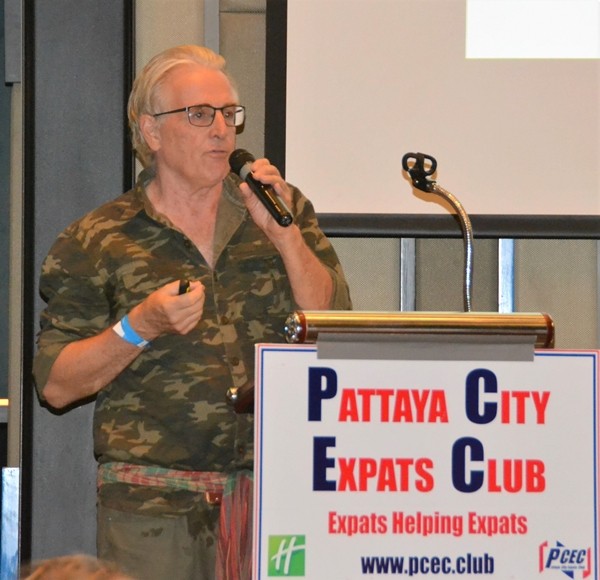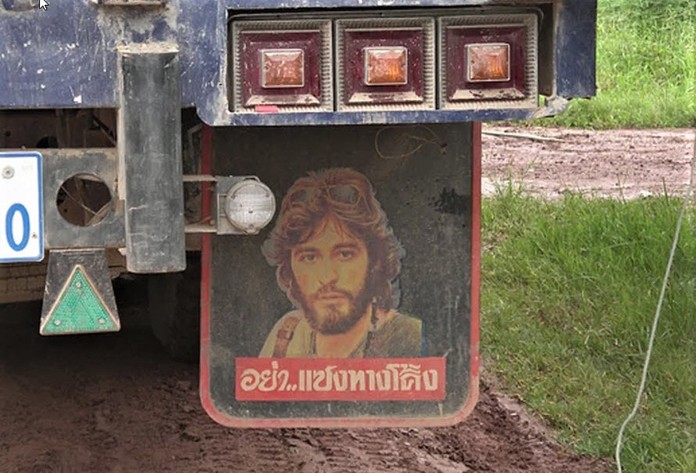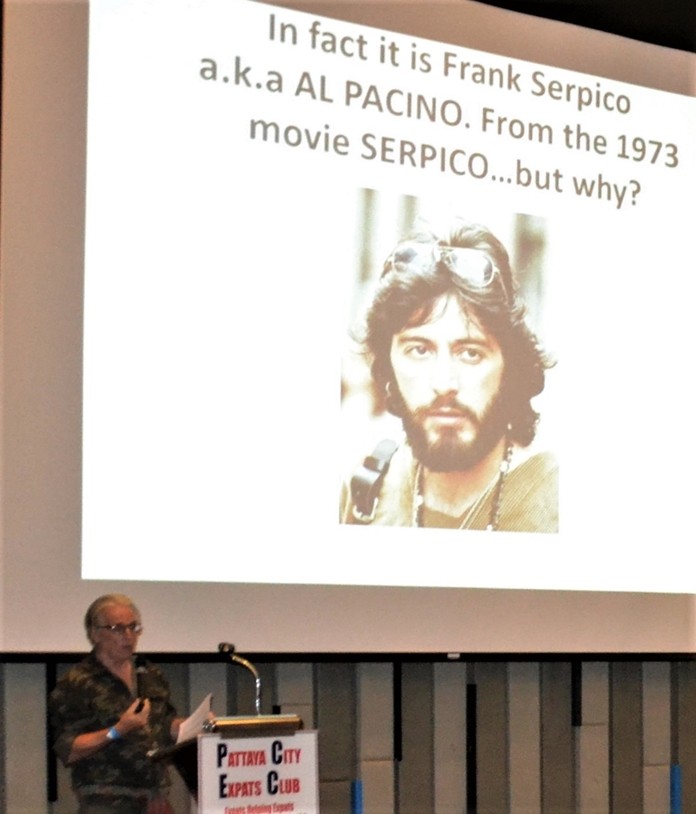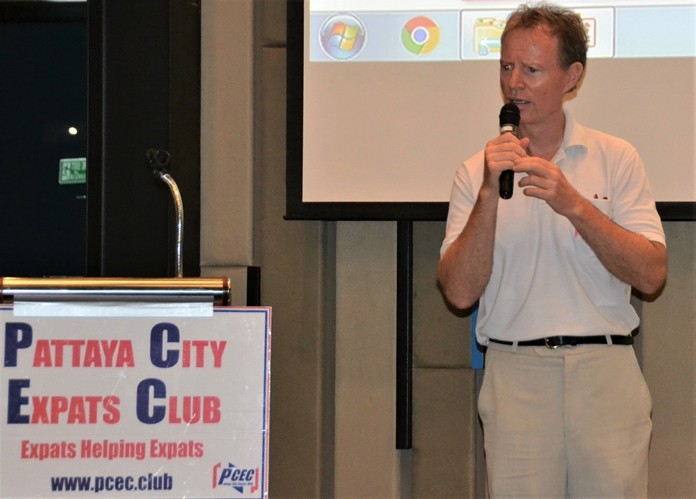
Dr. Stewart McFarlane, PhD took time from his busy schedule to talk to the Pattaya City Expats Club at their weekly meeting on Sunday, May 19. The title of his talk was, “Believe it or ‘mai dai’: Strange things about Thailand explained…” His talk primarily focused on some of the many symbols and images found in Thai culture.
Stewart is a writer, Buddhist scholar, researcher, animal welfare worker, dog trainer and author of several books regarding his many interests. Twelve years ago, he was drawn to Thailand by a need to help the elephants and the plight some were in. Today dog rescue work and sometimes pig rescue is his focus.

Using his thirty years’ experience of living in Thailand, Taiwan and Malaysia, he was happy to share his conclusions about strange things a foreigner may encounter in Thailand; a land he says, where the people believe in spirits. In both helpful spirits and unsettled spirits or ghosts. A Buddhist country where lucky charms, amulets, blessings and prayers are regularly used when asking for help or protection, which he pointed out, could be found in many Catholic countries.
Stewart began by pointing out two unusual images regularly found on trucks today. These are from the nineteen seventies. One is of Serpico the undercover cop in the film played by Al Pacino.
A character sent undercover to discover corruption within the police force. The other is Che Guevara, the famous icon of the Argentinian revolution. He explained that these images of macho men are used by drivers or companies as protection from trouble on the road. Or merely a warning not to tailgate, to stay back, don’t mess with me.
One of the “strange things” he shared was the very common practice of providing nicknames for babies. Babies being small and unable to protect themselves are often given nicknames as a form of protection against evil spirits; often, he explained, they are plain, even unattractive names. It is believed by doing so, spirits will not be attracted to them whilst they are small and vulnerable. For the same reason, a talisman of a phallic shape is sometimes tied around a male baby’s middle. In the hope spirits will think he is bigger and stronger than he is.
He further noted that the phallic shape can be found in many special places around Thailand. Again, this is seen he said as a symbol of strength, fortitude and protection. They are often carved larger than life, some as tall as a man. Sometimes painted red, a Yang or male colour, in a further attempt to convey strength. These carved phallic images are found displayed around old, large or holy trees, or in caves considered special or holy in some way. This is believed to guard and protect such special places from harm. One such cave is on the south of the Krabi peninsula; which he believes the shapes are there to protect nearby fishermen or maybe their village itself from harm. A holy tree surrounded by such images can be found in Bangkok, in the courtyard of a well-known hotel.

In a more everyday occurrence people have protection for their cars and passengers. New cars especially are blessed by monks. Recent figures show that 76% of Thai drivers do this. At the blessing, a white cord is often tied around the steering column, with good luck symbols painted on the dash. This is a ‘Yantra’ or protection against accidents or bad luck finding you on the road and to ward off bad spirits.
If you want to know more of his story and his many martial arts disciplines, visit his website on http//www.taichi-excercises.com/about.stewart-mcfarlane/. There you will also find a list of his books on Martial Arts, Buddhism, and much more.
Following Stewart’s talk, insurance broker Chamnong (Neng) Anusat-utai was invited to the stage to speak about a hot topic for expats caused by the recent articles about health insurance including both inpatient and outpatient care being required for retired expats living in Thailand. His overall comment was, “Don’t Panic!”
He explained that a similar health insurance requirement has been in effect for some time for applicants for the so-called ten-year visa (Non-Immigrant O-X Visa – visit the PCEC’s information on “Entering Thailand” on their Visa & Immigration webpage – www.pcec.club for more information about the O-X Visa).
However, he explained that there are no such requirements as yet in effect for expat retirees. Further, he noted the recent articles state that the incoming new requirements for health insurance will be for those applying for Non-Immigrant O-A visas (often called a retirement or long stay visa, these are obtained from Thai Embassies and Consulates in one’s country of residence).
Although the articles were not clear on whether those that are already living in Thailand on a Non-Immigrant O-A Visa will be subject to the requirement when renewing their extensions of stay, he did comment on those with who already have Thai health insurance policies without outpatient coverage. If the new health insurance requirement will apply, based on his inquiries with insurance providers, it will be unlikely that such coverage could be added to an existing Thai health insurance policy. To add outpatient coverage to an existing policy, you will most likely need to cancel your existing policy and obtain a new one to also include outpatient coverage.
After Neng’s talk, the PCEC’s resident guru on Immigration matters confirmed his comments and went on to add that at present, the only thing that appears certain once they go into effect is that the new requirement will apply only to those applying for a Non-Immigrant O-A Visa. He also cautioned not to panic and that the PCEC Newsletter and website will be updated with additional information from reliable sources when it becomes available.
After the presentations, the MC updated everyone on upcoming events which was followed by the Open Forum where the audience can ask questions or make comments about expat living in Thailand especially Pattaya.





